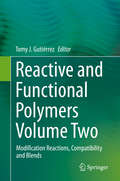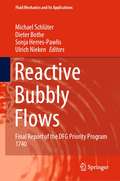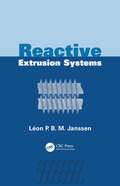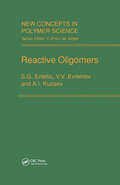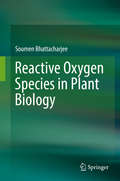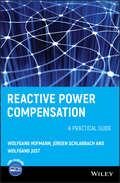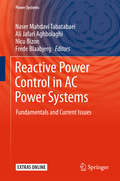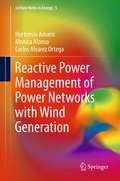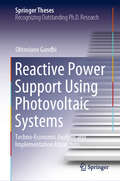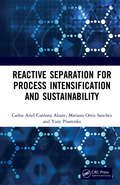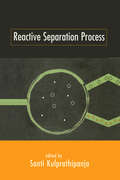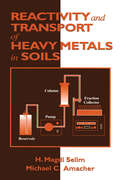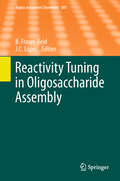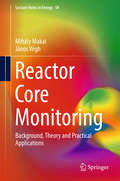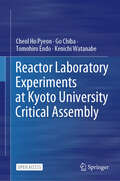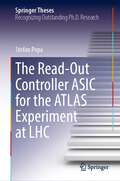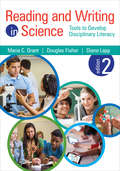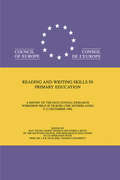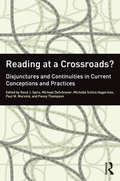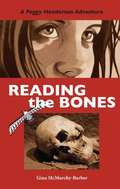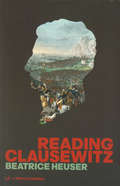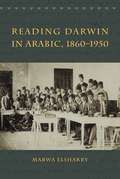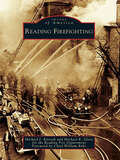- Table View
- List View
Reactive and Functional Polymers Volume Two: Modification Reactions, Compatibility and Blends
by Tomy J. GutiérrezReactive and functional polymers are manufactured with the aim of improving the performance of unmodified polymers or providing functionality for different applications. These polymers are created mainly through chemical reactions, but there are other important modifications that can be carried out by physical alterations in order to obtain reactive and functional polymers. This volume presents a comprehensive analysis of these reactive and functional polymers. Reactive and Functional Polymers Volume Two considers the coupling, crosslinking and grafting reactions to improve the compatibility of reactive and functional polymer blends. In this book, world-renowned researchers have participated, including Dr. Sabu Thomas (Editor-in-chief for the journal ‘Nano-Structures & Nano-Objects’). With its comprehensive scope and up-to-date coverage of issues and trends in Reactive and Functional Polymers, this is an outstanding book for students, professors, researchers and industrialists working in the field of polymers and plastic materials.
Reactive Bubbly Flows: Final Report of the DFG Priority Program 1740 (Fluid Mechanics and Its Applications #128)
by Michael Schlüter Dieter Bothe Sonja Herres-Pawlis Ulrich NiekenThis book presents experimental and numerical methods that have been developed during six years of targeted research within the DFG priority program SPP 1740, elucidating the interaction between hydrodynamics, mass transfer and transport as well as chemical reactions in bubbly flows. A special feature of this book is its focus on an interdisciplinary research approach with contributions from chemistry, mathematics and engineering sciences, providing enhanced or novel experimental methods, models and numerical simulations. This book provides fundamental knowledge to students about the current state of knowledge regarding transport processes in reactive bubbly flows as well as to scientists, emphasizing pressing research questions and further current demands for fundamental research. Engineers from the chemical industries will get valuable insights into relevant gas-liquid processes and benefit from recommendations concerning the design of gas-liquid reactors and laboratory experiments for studying the performance of gas-liquid reactions in their own lab.
Reactive Extrusion Systems
by Leon P.B.M. JanssenCiting recently realized applications for extruders as polymerization, modification, and degradation reactors and presenting a telling array of new research results and illustrative experimental cases, Reactive Extrusion Systems sheds light on the complex set of interactions underlying reactions in extruders. The book succeeds as a three-part surve
Reactive Oligomers
by S.G. Entelis V.V. Evreinov A.I. KuzaevReactive oligomers (ROs) constitute a starting material for the production of numerous polymeric materials with a pre-assigned set of physico-mechanical and physico-chemical properties. This book is the first to treat systematically various methods for determining the FTD and MWD of functional oligomers. Special attention is given to the application of liquid chromatography in different separation modes: exclusion (gel-permeation chromatography, GPC) and adsorption, as well as to the separation of functional oligomers in the critical region (SCR) at the boundary between the specified modes.
Reactive Oxygen Species in Plant Biology
by Soumen BhattacharjeeThis book highlights the latest advances made in the niche area of Reactive Oxygen Species and Redox processes in plants. It offers a valuable guide for researchers and students alike, providing insights into sensing, detox scavenging, the role in oxidative deterioration, and signaling associated with redox-regulatory processes in plants. The book also dramatically demonstrates how these amazingly resourceful molecular species and radicals are poised at the core of a sophisticated network of signaling pathways, and act as vital regulators of plants’ cell physiology and cellular responses to the environment. The molecular language associated with ROS-mediated signal transduction, which produces modulations in gene expression that determine plants’ stress acclamatory performance, is also discussed. The book subsequently provides information on current trends in redox proteomics and genomics, which include efforts to gain a fuller understanding of these redox players’ role in cellular processes, and to further the application of this knowledge to technology and agriculture. Given its scope and format, the book offers a valuable asset for students of Plant Sciences, Agriculture, and Molecular Biology, as well as readers engaged in research on and teaching ROS Biology.
Reactive Power Compensation
by Wolfgang Hofmann Wolfgang Just Jürgen SchlabbachThe comprehensive resource on reactive power compensation, presenting the design, application and operation of reactive power equipment and installationsThe area of reactive power compensation is gaining increasing importance worldwide. If suitably designed, it is capable of improving voltage quality significantly, meaning that losses in equipment and power systems are reduced, the permissible loading of equipment can be increased, and the over-all stability of system operation improved. Ultimately, energy use and CO2 emisson are reduced.This unique guide discusses the effects of reactive power on generation, transmission and distribution, and looks at the compensation of existing installations in detail. It outlines methods for determination of reactive power and answers the questions that arise when controlling it, for example, at parallel operation with generators. There is also a chapter devoted to installation, maintenance and disturbances.Key features include:A concise overview as well as deep specific knowledge on the segment power factor regulation and network qualityTheory of reactive power compensation coupled with typical application examples such as car manufacturing, metal rolling and chemical worksChapter summaries with charts explaining how to put the theory into practiceCoverage on the cost-saving aspects of this technology, including the efficient use of energy and the reduction of CO2A practical guide for electrical engineers and technicians in utilities, this is also essential reading for maintenance engineers, designers, electrical contractors, manufacturing companies, and researchers, also those in industry and planning agencies. Insightful and clear, the book will also appeal to senior undergraduate and graduate electrical engineering students and professors.
Reactive Power Control in AC Power Systems
by Frede Blaabjerg Nicu Bizon Naser Mahdavi Tabatabaei Ali Jafari AghbolaghiThis textbook explores reactive power control and voltage stability and explains how they relate to different forms of power generation and transmission. Bringing together international experts in this field, it includes chapters on electric power analysis, design and operational strategies. The book explains fundamental concepts before moving on to report on the latest theoretical findings in reactive power control, including case studies and advice on practical implementation students can use to design their own research projects. Featuring numerous worked-out examples, problems and solutions, as well as over 400 illustrations, Reactive Power Control in AC Power Systems offers an essential textbook for postgraduate students in electrical power engineering. It offers practical advice on implementing the methods discussed in the book using MATLAB and DIgSILENT, and the relevant program files are available on the book's website.
Reactive Power Management of Power Networks with Wind Generation
by Monica Alonso Hortensia Amaris Carlos Alvarez OrtegaAs the energy sector shifts and changes to focus on renewable technologies, the optimization of wind power becomes a key practical issue. Reactive Power Management of Power Networks with Wind Generation brings into focus the development and application of advanced optimization techniques to the study, characterization, and assessment of voltage stability in power systems. Recent advances on reactive power management are reviewed with particular emphasis on the analysis and control of wind energy conversion systems and FACTS devices. Following an introduction, distinct chapters cover the 5 key areas of FACTS devices, voltage stability, wind generators, reactive power optimization and management. These are supported with applications and example including real-life data from the Spanish Power system. Together with power system engineers, operators and planners will also benefit from this insightful resource. Reactive Power Management of Power Networks with Wind Generation provides a key reference to advanced undergraduate and graduate students in electrical and power engineering.
Reactive Power Support Using Photovoltaic Systems: Techno-Economic Analysis and Implementation Algorithms (Springer Theses)
by Oktoviano GandhiWith the widespread adoption of photovoltaic (PV) systems across the world, many researchers, industry players, and regulators have been exploring the use of reactive power from PV to support the grid. This thesis is the first to comprehensively quantify and analyse the techno-economic cost and benefits of reactive power support using PV. On top of formulating the cost of PV reactive power and identifying the feasible range of its monetary incentives, this thesis has also proposed practical methods to implement the reactive power dispatch effectively and efficiently, with and without communication infrastructure. The findings and approaches in this work can therefore help power system planners and operators towards better integration of PV into the electrical grid, both in terms of regulation and implementation.
Reactive Separation for Process Intensification and Sustainability
by Carlos Ariel Alzate Mariana Ortiz Sanchez Pisarenko Yury AndrianovichThis book describes, analyses and discusses the main principles, phenomena and design strategies of reactive separation processes with an emphasis on the intensification as a basis of the sustainability. Different reactive separation processes are explained in detail to show the phenomena and with the purpose of understanding when their use allows advantages based on the output results. Case examples are analysed and the perspective of these processes in the future is discussed. The overall sustainability of reactive separation processes in the industry is also explained separately.
Reactive Separation Processes
by KulprathipanjaThis book summarizes the available information in six known areas of reactive separation: reaction/distillation, reaction/extraction, reaction/absorption, reaction/adsorption, reaction/membrane, and reaction/crystallization.
Reactivity and Transport of Heavy Metals in Soils
by H. Magdi Selim Michael C. AmacherThe fate of heavy metal particles in the environment is important because they tend to be reactive, mobile, and highly toxic. Reactivity and Transport of Heavy Metals in Soils examines the sometimes complex interactions that occur between metals and the soil they occupy. It discusses basic kinetic concepts and covers the predictability and consequences of metal-soil interactions.This practical guide presents and explains heavy metal issues crucial to hazardous waste site cleanup, including:
Reactivity Tuning in Oligosaccharide Assembly
by Bert Fraser-Reid J. Cristóbal LópezArmed-Disarmed Effects in Carbohydrate Chemistry: History, Synthetic and Mechanistic Studies, by Bert Fraser-Reid and J. Cristóbal López * A Survey of Ley's Reactivity Tuning in Oligosaccharide Synthesis, by Ana M. Gómez * "Active-Latent" Thioglycosyl Donors and Acceptors in Oligosaccharide Syntheses, by Tze Chieh Shiao and René Roy * Effect of Electron-Withdrawing Protecting Groups at Remote Positions of Donors on Glycosylation Stereochemistry, by Kwan Soo Kim and Dae-Hwan Suk * Influence of Protecting Groups on the Reactivity and Selectivity of Glycosylation: Chemistry of the 4,6-O-Benzylidene Protected Mannopyranosyl Donors and Related Species, by Sylvain Aubry, Kaname Sasaki, Indrajeet Sharma and David Crich * Superarmed and Superdisarmed Building Blocks in Expeditious Oligosaccharide Synthesis, by Hemali D. Premathilake and Alexei V. Demchenko * Programmable One-Pot Glycosylation, by Chung -Yi Wu and Chi -Huey Wong * Uronic Acids in Oligosaccharide and Glycoconjugate Synthesis, by Jeroen D. C. Codée, Alphert E. Christina, Marthe T. C. Walvoort, Herman S. Overkleeft and Gijsbert A. van der Marel
Reactor Core Monitoring
by Mihály Makai János VéghThis book presents a comprehensive overview of the computerized core monitoring techniques currently employed at pressurized water reactor (PWR) and boiling water reactor (BWR) nuclear power plants. It also offers a brief overview of the corresponding techniques at research and materials testing reactors. The book combines detailed descriptions of the theoretical background and fundamental underlying principles as well as the practical applications of core surveillance. It not only provides numerous industrial examples to illustrate how complex computerized systems are able to support the safe operation of nuclear reactors, but also outlines some new application areas that were made possible only by state-of-the-art computing resources. Thanks to its practical approach, it serves as a valuable and practical reference book for readers interested in the surveillance of nuclear reactors, ranging from undergraduate and postgraduate students to researchers and experts working at research reactors and nuclear power plants, as well as at nuclear regulatory authorities.
Reactor Laboratory Experiments at Kyoto University Critical Assembly
by Cheol Ho Pyeon Go Chiba Tomohiro Endo Kenichi WatanabeThis open access is an educational text on reactor physics experiments and is described based on a careful examination of the contents and pedagogical benefits obtained from the book Nuclear Reactor Physics Experiments by T. Misawa, H. Unesaki, and C. H. Pyeon (2010) from Kyoto University Press, Japan. The current volume comprehensively covers basic and applied topics on experiment using nuclear reactors, including exponential experiment, uranium enrichment measurement and subcriticality measurements, in addition to approach-to-criticality experiment, control rod calibration experiment, and reaction rate measurement by the activation foil method. This book is intended for graduate students who have already studied reactor physics and radiation detection in an undergraduate program. Readers who have not yet studied these two areas or who wish to review them are recommended to read the companion book Introduction to Nuclear Reactor Experiments, by G. Wakabayashi, T. Yamada, T. Endo, and C.H. Pyeon (2023) from Springer, covering basic concepts and theories of reactor physics and radiation detection. This volume provides a systematic understanding of reactor physics experiments, complemented by its companion book by Wakabayashi et al.
The Read-Out Controller ASIC for the ATLAS Experiment at LHC (Springer Theses)
by Stefan PopaThis thesis presents the complete chain from specifications to real-life deployment of the Read Out Controller (ROC) ASIC for the ATLAS Experiment at LHC, including the design of the FPGA-based setup used for prototype validation and mass testing of the approximately 6000 chips. Long-lasting experiments like the ATLAS at the LHC undergo regular upgrades to improve their performance over time. One of such upgrades of the ATLAS was the replacement of a fraction of muon detectors in the forward rapidities to provide much-improved reconstruction precision and discrimination from background protons. This new instrumentation (New Small Wheel) is equipped with custom-designed, radiation-hard, on-detector electronics with the Read Out Controller chip being a mission-critical element. The chip acts as a clock and control signals distributor and a concentrator, buffer, filter and real-time processor of detector data packets. The described and deployed FPGA-based test setup emulates the asynchronous chip context and employs optimizations and automatic clock and data synchronization. The chip's tolerance to nuclear radiation was evaluated by recording its operation while controlled ultrafast neutron beams were incident to its silicon die. Predictions for the operating environment are made. A proposed implementation of an FPGA Integrated Logic Analyzer that mitigates the observed limitations and constraints of the existing ones is included.
Reader's Digest Quintessential Guide to Healthy Eating
by Editors at Reader's DigestA clear, fresh and frequently surprising guide to good, nutritious food; Inside you will find expert, unbaised information on what is good for us and what is not.The Reader's Digest Quintessential Guides do what the Reader's Digest does better than anyone: the best advice, straight to the point. It will help you sort out the facts, clearing the path to the best, healthiest food for your well being. Inside you will learn: The best food to avoid The best food to seek out how to transform your diet for better health and still savor and enjoy great-tasting food This is your basic guide to modern nutrition, covering hundereds of everyday foods and ingredients.
Reading and Writing in Science: Tools to Develop Disciplinary Literacy
by Douglas Fisher Maria C. Grant Diane K. LappEngage your students in scientific thinking across disciplines! Did you know that scientists spend more than half of their time reading and writing? Students who are science literate can analyze, present, and defend data – both orally and in writing. The updated edition of this bestseller offers strategies to link the new science standards with literacy expectations, and specific ideas you can put to work right away. Features include: A discussion of how to use science to develop essential 21st century skills Instructional routines that help students become better writers Useful strategies for using complex scientific texts in the classroom Tools to monitor student progress through formative assessment Tips for high-stakes test preparation
Reading and Writing in Science: Tools to Develop Disciplinary Literacy
by Maria C. Grant Douglas Fisher Diane K. LappEngage your students in scientific thinking across disciplines! Did you know that scientists spend more than half of their time reading and writing? Students who are science literate can analyze, present, and defend data – both orally and in writing. The updated edition of this bestseller offers strategies to link the new science standards with literacy expectations, and specific ideas you can put to work right away. Features include: A discussion of how to use science to develop essential 21st century skills Instructional routines that help students become better writers Useful strategies for using complex scientific texts in the classroom Tools to monitor student progress through formative assessment Tips for high-stakes test preparation
Reading And Writing Skills In Primary Education
by Pamela Munn Marie Thomas May YoungThis book summarizes aspects of reading and writing in primary schools, interest to educationists in the UK. It outlines the general process of reading comprehension into different levels.
Reading at a Crossroads?: Disjunctures and Continuities in Current Conceptions and Practices
by Penny Thompson Rand J. Spiro Michael DeSchryver Michelle Schira Hagerman Paul M. MorsinkThe Internet is transforming the experience of reading and learning-through-reading. Is this transformation effecting a radical change in reading processes as readers synthesize understandings from fragments across multiple texts? Or, conversely, is the Internet merely a new place to use the same reading skills and processes developed through experience with traditional print-based media? Are the changes in reading processes a matter of degree, or are they fundamentally new? And if so, how must reading theory, research, and instruction adjust? This volume brings together distinguished experts from the fields of reading research, teacher education, educational psychology, cognitive science, rhetoric and composition, digital humanities, and educational technology to address these questions. Every question is not answered in every chapter. How could they be? But every contributor has many thoughtful things to say about a subset of these important questions. Together, they add up to a comprehensive response to the issues the field faces as it approaches what may well be—or not —a crossroads. A website devoted to extending discussion around the book in creative (and disjunctive) ways [readingatacrossroads.net] moves it beyond the printed page.
Reading The Bones
by Gina Mcmurchy-BarberShort-listed for the 2009 Silver Birch Award, commended for the 2009 Best Books for Kids & Teens Due to circumstances beyond her control, 12-year-old Peggy Henderson has to move to the quiet town of Crescent Beach, British Columbia, to live with her aunt and uncle. Without a father and separated from her mother, who's looking for work, Peggy feels her unhappiness increasing until the day she and her uncle start digging a pond in the backyard and she realizes the rock she's been trying to pry from the ground is really a human skull. Peggy eventually learns that her home and the entire seaside town were built on top of a 5000-year-old Coast Salish fishing village. With the help of an elderly archaeologist, a woman named Eddy, Peggy comes to know the ancient storyteller buried in her yard in a way that few others can - by reading the bones. As life with her aunt becomes more and more unbearable, Peggy looks to the old Salish man from the past for help and answers.
Reading Clausewitz
by Beatrice HeuserClausewitz's On War, first published in 1832, remains the most famous study of the nature and conditions of warfare. Contemporaries found him 'endearing' or 'totally unpalatable', while later generations called him 'the father of modern strategical study', whose tenets have 'eternal relevance', or dismissed him as outdated. Was it really he who made the discovery that warfare is a continuation of politics? Was he the 'Mahdi of mass and mutual massacre', in part responsible for the mass slaughter of the First World War, as Liddell Hart contended? Can the idea of total war be traced back to him? Complex and often misunderstood, Clausewitz has fascinated and influenced generations of politicians and strategic thinkers. Beatrice Heuser's study is the first book, not only on how to read Clausewitz, but also on how others have read him - from the Prussian and German masters of warfare of the late nineteenth century through to the military commanders of the First World War, through Lenin and Mao Zedong to strategists in the nuclear age and of guerrilla warfare. The result is an accessible and comprehensive introduction to the work and influence of the greatest classic on the art of war.
Reading Darwin in Arabic, 1860-1950
by Marwa ElshakryIn "Reading Darwin in Arabic," Marwa Elshakry questions current ideas about Islam, science, and secularism by exploring the ways in which Darwin was read in Arabic from the late 1860s to the mid-twentieth century. Borrowing from translation and reading studies and weaving together the history of science with intellectual history, she explores DarwinOCOs global appeal from the perspective of several generations of Arabic readers and shows how DarwinOCOs writings helped alter the social and epistemological landscape of the Arab learned classes. aaaaaaaaaaaProviding a close textual, political, and institutional analysis of the tremendous interest in DarwinOCOs ideas and other works on evolution, Elshakry shows how, in an age of massive regional and international political upheaval, these readings were suffused with the anxieties of empire and civilizational decline. The politics of evolution infiltrated Arabic discussions of pedagogy, progress, and the very sense of history. They also led to a literary and conceptual transformation of notions of science and religion themselves. Darwin thus became a vehicle for discussing scriptural exegesis, the conditions of belief, and cosmological views more broadly. The book also acquaints readers with Muslim and Christian intellectuals, bureaucrats, and theologians, and concludes by exploring DarwinOCOs waning influence on public and intellectual life in the Arab world after World War I. "aaaaaaaaaaa ""Reading Darwin in Arabic "is an engaging and powerfully argued reconceptualization of the intellectual and political history of the Middle East. "
Reading Firefighting (Images of America)
by Michael R. Glore Michael J. Kitsock Chief William Rehr Reading Fire DepartmentFrom its inception in Colonial times to the modern challenges of today, the Reading Fire Department has battled natural disasters, airplane crashes, and block burners threatening "the Pretzel City." The fire department has faithfully served the city of Reading since 1771, having been established soon after Benjamin Franklin organized the nation's first volunteer fire department in Philadelphia. At one time the Reading Fire Department even boasted the largest all-volunteer fire department in the nation, consisting of more than 10,000 volunteer members operating from 14 fire stations throughout the city. Using the archives of the Reading Fire Department, the Reading Eagle, and the Historical Society of Berks County, Reading Firefighting documents the history and traditions of this dedicated fire department.
